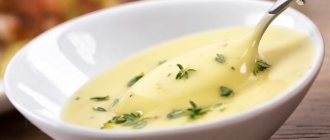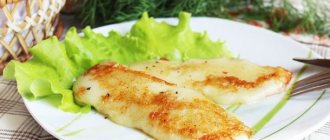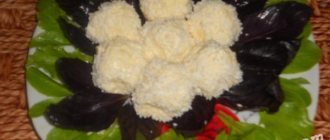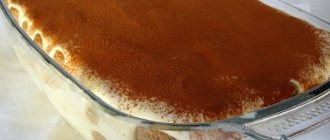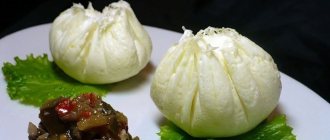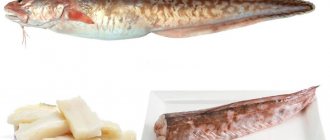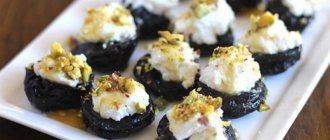| Bree | |
| Brie | |
| Country of origin | France France |
| City, region | Brie, Ile-de-France |
| Milk | cow |
| Pasteurized | no (in Europe), required in the USA and Australia |
| Texture | soft, pale in color with a grayish tint under a “noble” white mold |
| Ripening time | at least 4 weeks |
| Certification | AOC 1980 |
| USDA NDB code | 01006 |
| Bree at Wikimedia Commons | |
Brie
(French Brie) is a soft cheese made from cow's milk[1], which received its name from the French province (located in the central region of Ile-de-France near Paris), where it was first made.
Bree
- one of the most famous French cheeses, known throughout the world. However, since this name unites a large number of individual varieties, it is more correct to talk about the brie cheese family.
Many types of cheese are produced in different countries, including the common brie.
, herbed cheese, double and triple
brie
and non-cow's milk varieties.
There are more than a dozen varieties of brie
, but only two types - Brie de Meaux
and
Brie de Melun
,
named after small towns located east of Paris, have AOC certification in France (French Appellation d 'origin control).
Story
Bree
- one of the most ancient French cheeses. It is known that this was one of the most popular cheeses back in the Middle Ages.
Bree
has always been the cheese of kings.
Blanca of Navarre, Countess of Champagne, used to send brie
as a gift to King Philip Augustus, who was delighted with it.
When Christmas arrived, the ladies of the court always looked forward to fresh brie
.
Queen Margot and Henry IV were big fans of brie
Dessert with strawberry sauce
Ingredients:
- cheese Brie from Zhukovka;
- puff pastry – 500 gr.;
- strawberries – 250 gr.;
- chicken egg – 1 pc.;
- granulated sugar – 50 gr.
Step by step recipe
- Cover the strawberries with sugar, add water and bring to a boil. Remove from heat and let the berries cool thoroughly.
- Grind in a blender.
- Grind the resulting puree through a sieve. Strawberry sauce is ready.
- Roll out the dough thinly.
- Cut 2 circles out of it: 1 with a diameter of a cheese head, the other - 5 cm larger.
- Make a hole in the center of the cheese and place a large strawberry there. Place the cheese on a large dough circle. Bring the edges up and secure to the sides of the cheese.
- Cover the resulting workpiece with a small circle on top and carefully fasten the edges.
- Place the dish in the oven for 20 minutes at 200°C.
- Serve hot, garnished with strawberry sauce.
These dishes are suitable for any occasion: a romantic dinner with your loved one, a party with friends, a business lunch with partners, and their taste will delight the most picky critics. The main thing is to properly reveal the noble taste of the cheese.
Peculiarities
Brie is characterized by a pale color with a grayish tint under the “noble” white mold (Penicillium camemberti or Penicillium candidum). The shape is “cakes” with a diameter of 30-60 centimeters and a thickness of 3-5 centimeters. The cheese is soft and pleasant to the taste with a slight smell of ammonia. The mold crust has a pronounced ammonia aroma, but is edible.
Young brie
has a soft and delicate taste.
As it ripens, the flesh becomes pungent. The thinner the brie ,
the spicier the cheese.
Brie
is produced at any time of the year, and it is one of the most “universal” French cheeses, as it goes well with both the festive table and a regular lunch.
Brie
is best eaten when it is at room temperature, so it must be removed from the refrigerator (or cellar) in advance. It is better to store at a temperature of +2…-4 °C.
Bree
The taste is similar to Camembert, but its fat content is slightly lower - 25%.
Red onion jam
Ingredients for 4 servings:
- 30 ml olive oil;
- 300 g red onion;
- 200 ml dry red wine;
- 50 g sugar;
- 10 g chopped thyme leaves;
- 30 ml balsamic vinegar;
- 5 g salt;
- 2 g crushed black pepper;
Cooking method:
- Heat olive oil in a small saucepan over medium heat until simmering. Add the onion and cook until soft and translucent, stirring occasionally. This will take 8-10 minutes.
- Add sugar, thyme, vinegar and salt to the wine. Bring to a boil, then reduce heat and let simmer until liquid thickens (this will take about an hour). Stir occasionally. Season with salt and pepper to taste.
- Transfer the onion jam to a bowl and let cool, then serve or store in an airtight container in the refrigerator for up to 2 weeks.
Serve onion jam at room temperature.
-What is your favorite dish?
— For example, baked Camembert. The taste becomes unsurpassed when baked with garlic, fresh herbs and white wine. Baked camembert is served with a baguette with a crispy crust. And another favorite dish is fresh buratta cheese with honey in a honeycomb, drizzled with balsamic. This cheese is served with pieces of toasted baguette.
Buratta with honey - tasty and unusual
Links
- Soft cheeses with mold rind
- History and characteristics of brie cheeses (French)
| French cheeses | ||
| From cow's milk |
| |
| From goat's milk |
| |
| From sheep's milk |
| |
Mold
There are three main categories of cheese in which the presence of mold is an important feature: soft rennet cheeses, pickled cheeses and blue cheeses.
Soft rennet
Soft, ripened cheeses begin to harden and begin to turn slightly white, but over time, the outside and inside become moldy. The mold can be a velvety coating such as Penicillium candida or Penicillium camemberti, which forms a pliable white rind and contributes to the smooth, runny or sticky texture and more intense flavor of these cheeses over time. Brie and Camembert, the most famous of these cheeses, are made by allowing white mold to grow on the outside of soft cheeses for several days or weeks. Goat's milk cheeses are often processed this way, sometimes with white mold and sometimes with blue mold.
Brine
Brine cheeses are soft in character and ripen internally similar to those with white mold. However, they are processed differently. Brine cheeses are periodically cured in a salt water brine solution and molds are born, which can include beer, wine, cognac and spices, making their surface susceptible to bacteria of the class Brevibacterium linens (reddish-orange spots of bacteria), which give a piquant flavor and distinctive aroma, and creating a hard, tasty crust around the cheese. Brine cheeses can be soft (Limburger), semi-hard or hard (Appenzeller). The same bacteria may also have a different effect on cheeses than those simply ripened in humid conditions, like Camembert. The process requires regular rinsing especially in the early stages of production, making it quite labor intensive compared to other cheese production methods.
Cheeses ripened by dirt
Some brine cheeses, like mud-ripened cheeses, are ripened in a solution of bacteria or fungi, usually Brevibacterium linens, Debaryomyces hansenii and Geotrichum candidum, which usually give them a strong aroma once the cheese ripens. In some cases, old cheeses are mixed with young cheeses to transfer microorganisms. Many, but not all, of these cheeses have a distinctive pinkish or orange color on the outside. Unlike other brined cheeses, rinsing allows for the growth of desired bacteria or fungi and prevents the growth of unwanted mold. Prominent examples of dirt-ripened cheeses are Muenster and por salu.
Blue
So-called blue cheeses were created by grafting them with Penicillium roqueforti or Penicillium glaucum. This is done while they are still in the form of a free curd and can further increase penetration into the ripening block of cheese by creating air channels with needles through which mold develops inside the cheese. Mold grows inside the cheese over time. These cheeses have the distinct blue veins that give them their name, and often, a good aroma. Mold ranges in color from pale green to dark blue, and may be accompanied by white and hard brown forms. Their texture can be soft or hard. Some of the most famous cheeses of this type have their own distinctive color, taste, texture and aroma. For example, Roquefort, Gorgonzola and Stilton.
The first mentions of cheese in Rus'
Generally speaking, the word “cheese” has been familiar to our ancestors for a long time.
“Domostroy,” written in the mid-16th century, uses it more than a dozen times. Yes, and in earlier chronicles, no, no, yes, you will come across this word. The “mandate list” of Grand Duke Ivan Vasilyevich (Ivan III) in 1498 orders that “a rug of bread and cheese” be collected from the peasants for feeding on Peter’s Day. And the earlier “Russkaya Pravda” (dating to the 11th century) defines “for food the virnik (prince’s servant) should take 7 buckets of malt for a week, and on Wednesday there is cut cheese, and on Friday the same.” Just what kind of “cheese” this was then, history is silent. Today we can only guess that cheese was then a kind of cottage cheese. In fact, young or unripe cheese is exactly what we know from cottage cheese, feta cheese and homemade cheese. This type also includes Italian ricotta and mascarpone. They do not need to ripen, like varieties of hard or soft cheeses. Their recipe (with minor variations) is simple. The heated milk and cream are fermented by the addition of starter. The whey is separated, and the cheese mass itself acquires a thick, creamy consistency. During the process, you can salt it, add herbs and spices.
More aged cheese could be slightly smoked. But all this was very far from European analogues. After all, Swiss cheese and Roquefort appeared there in the 11th century, Gruyère and Cheshire cheese in the 12th century, and the 13th century was marked by the invention of Parmesan, Gorgonzola, Pecorino and Emmental.
Today's public discourse, naturally, could not do without statements about ancient Russian cheeses, which were far ahead of foreign ones. And they arose almost under Vladimir the Red Sun. However, here sometimes the fantasies of people far from historical science replace reality. Supporters of “ancient Russian cheeses” cite as an argument a quote from “Domostroy” (Wedding Ceremony), where the groom’s groomsman “breaks the cheese” during the wedding, with a hint that it was hard. It would be interesting to see how you can “break” modern cheese like cheddar, Swiss or Kostroma with your hands. But it is quite possible to break some dense cheese. Which, as you understand, only confirms our version.
In any case, history has not brought us any recipes for these “original” domestic cheeses. And attempts to reconstruct them today are nothing more than a game of fantasy. Therefore, we can more or less confidently say that there were cheeses in medieval Rus', but they were not cooked, and these cheeses turned out to be similar to today’s pickled cheeses - feta cheese, Adyghe cheese, feta, suluguni.
Recipes with Brie cheese
All varieties of this product are in demand among chefs when creating main courses, sauces, appetizers, and desserts. It can even be fried and served with a sour berry dressing. Recipes with Brie cheese are present in the cuisine of almost every European country. If you are just getting acquainted with this product and have not fully appreciated the smell and taste, start culinary experiments with salads.
Salad
As previously stated, this product goes well with fruits and nuts, so it is actively used by chefs for salads, which will add a delicate creamy note. Their composition can be almost anything, but you shouldn’t add animal protein to it - it’s better to choose seafood. If you're looking for a holiday option, try a simple salad with Brie cheese, avocado, grapefruit and toasted pine nuts.
Ingredients:
- lettuce – 110 g;
- grapefruit – 170 g;
- avocado – 200 g;
- Brie – 100 g;
- pine nuts (kernels) – 70 g;
- salt.
Cooking method:
- Remove membranes from grapefruit slices and cut into small pieces.
- Remove the pit from the avocado, remove the skin, and cut the pulp in the same way.
- Wash the lettuce and pat dry with napkins. Tear coarsely.
- Fry the nuts (do not add oil) until golden brown.
- Combine these components, add salt, mix, and arrange in a mound. Evenly distribute cheese cut into square pieces on top.
Find out the benefits of grapefruit.
Pie
Desserts with this elite product delight everyone who tries even a small piece. An open-faced French shortbread Brie pie is perfect for a holiday or even to add some variety to a regular breakfast. Crispy bottom layer, soft center, sweetness of pears and creamy taste of cheese - this recipe for a magical treat will become your favorite with a minimum of effort. If desired, Brie can be replaced here with Camembert.
Ingredients:
- butter – 125 g;
- flour – 250 g;
- sugar – 70 g;
- eggs – 2 pcs.;
- pears – 450 g;
- Brie – 120 g;
- sour cream – 70 g;
- lemon juice – 20 ml;
- vanilla sugar – 1 tsp.
Cooking method:
- Make a simple shortcrust pastry by rubbing cold butter crumbs with sugar, flour and egg yolks. Cool before stretching into round shape. The height of the sides should be about 4 cm.
- Bake at 200 degrees for 10 minutes.
- Peel the pears, cut them into thin slices, and place them inside the pie base. Sprinkle with lemon juice.
- Place cheese cut into wide slices on top, pour in a mixture of sour cream with whipped egg whites and vanilla sugar.
- Continue baking at the same temperature until the pie filling is browned.
Cheshire
Cheshire cheese was one of the standard cheeses for Medieval England. All other cheeses were then made following his example. At the beginning of the century, Cheshire cheese and Stilton were the only British cheeses that were known and respected in neighboring gourmet France. At the beginning of the twentieth century, there were more than 1,200 cheese factories in Great Britain that produced Cheshire. After World War II, their number decreased by 60%. Now this hard cheese is produced by only a few farms and only one - Appelby's of Hawkstone - brews the national cheese using old technology - from unpasteurized milk from the cows of their herd, which graze on a Cheshire pasture near the salt mines, which adds natural saltiness to the cheese. Cheshire cheeses have a loose, slightly flaky consistency.


